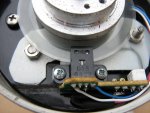I am investigating the possibility of using a SRF005 based ultrasonic module to accurately measure the amount of heating oil in my tank and send it via a wireless link to a receiver - yes, I am aware that commercial units are available but their resolution is extremely low (e.g. in tenths of the tank) and they are quite expensive.....and of course I am a PICAXE fan !
The spec sheet says ....The length of the echo pulse is then divided by 5.8 to give a value in cm.......could it I wonder be modified to give an output in mm or tenths of mm perhaps ?
My 1385 lt tank is 6ft x 4ft x 2ft which equates to approximately 1.1361 lt/mm or 0.8801 mm/lt.
My idea is not only to indicate the actual level of oil remaining in the tank but also to be able to plot the consumption on a graph (probably via Excel) so the measurement head needs to have quite high resolution.
Anyone had any similar ideas ?
Any other suggestions.....apart from to get a life that is
The spec sheet says ....The length of the echo pulse is then divided by 5.8 to give a value in cm.......could it I wonder be modified to give an output in mm or tenths of mm perhaps ?
My 1385 lt tank is 6ft x 4ft x 2ft which equates to approximately 1.1361 lt/mm or 0.8801 mm/lt.
My idea is not only to indicate the actual level of oil remaining in the tank but also to be able to plot the consumption on a graph (probably via Excel) so the measurement head needs to have quite high resolution.
Anyone had any similar ideas ?
Any other suggestions.....apart from to get a life that is
Last edited:

